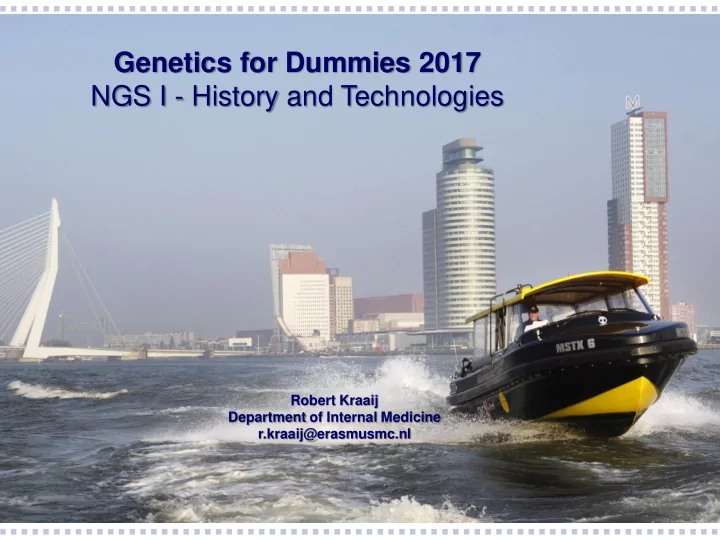

DepthOfCoverage Genetics for Dummies 2017 NGS I - History and Technologies Robert Kraaij Department of Internal Medicine r.kraaij@erasmusmc.nl
Things to be addressed Sanger sequencing: how it began NGS: many short reads that might contain errors Third generation sequencing: now available!
What will NGS bring us? RFLP TaqMan Array Array and Imputation Regional Sequencing Full Genome Sequencing
Overview • First Generation: Sanger sequencing • Next (Second) Generation • Third Generation
1953: Double-Helix Model of DNA James D. Watson and Francis Crick 4 nucleotides 2 strands A-T and C-G pairing from wikipedia.org
1970: HindII the First Restriction Enzyme - A A G C T T - - 3’ 5’ - - T T C G A A - 3’ - - 5’ Hamilton O. Smith isolation of clonal DNA fragments from wikipedia.org
1977: Maxam & Gilbert Sequencing Walter Gilbert from wikipedia.org
Maxam & Gilbert Sequencing G G+A C+T C
1977: Sanger Sequencing Frederick Sanger from wikipedia.org
Sanger Sequencing
Sanger Sequencing
Sanger Sequencing
Sanger Sequencing G C A T
Sanger Sequencing G A T C
Sanger sequencing landmarks • 1977 bacteriophage φ X174 5.4 kb • 1984 Epstein-Barr virus 170 kb • 1995 Haemophilus influenzae 1.8 Mb • 2001 Human 3 Gb from wikipedia.org
The Human Genome Project Bill Clinton Tony Blair Craig Venter Francis Collins June 26 th , 2000 : working draft, 95% gesequenced April 14 th , 2003 : finished: 99% gesequenced. Costs : $ 2.7 billion (instead of $ 3 billion) Timing : 1990 - 2003 (instead of 2005)
Overview • First Generation: Sanger sequencing • Next (Second) Generation • Third Generation
Next Generation: Roche 454
Roche 454 • fragment DNA • clonal amplification on bead by emPCR • load beads in PicoTiterPlate • sequencing-by- synthesis
Roche 454 • fragment DNA • clonal amplification on bead by emPCR • load beads in micro-reactors PicoTiterPlate water-in-oil emulsion • sequencing-by- synthesis
Roche 454 • fragment DNA • clonal amplification on bead by emPCR • load beads in PicoTiterPlate • sequencing-by- synthesis
Roche 454 A • fragment DNA • clonal amplification on bead by emPCR • load beads in PicoTiterPlate • sequencing-by- synthesis
Roche 454 • fragment DNA A G C T etc. • clonal amplification on bead by emPCR • load beads in PicoTiterPlate • sequencing-by- synthesis
Roche 454 • fragment DNA • clonal amplification on bead by emPCR • load beads in PicoTiterPlate • sequencing-by- synthesis A A A T C G G G G G C A
Next Generation: Ion Torrent
Ion Torrent • fragment DNA • clonal amplification on bead by emPCR • load beads on chip • sequencing-by- synthesis
Ion Torrent A • fragment DNA • clonal amplification on bead by emPCR • load beads on chip • sequencing-by- synthesis
Ion Torrent • fragment DNA T G A C etc. • clonal amplification on bead by emPCR • load beads on chip • sequencing-by- synthesis
Ion Torrent • fragment DNA • clonal amplification on bead by emPCR • load beads on chip • sequencing-by- synthesis A A A T C G G G G G C A
Next Generation: Illumina
Sequencing Workflow Library Data DNA preparation Sequencing analysis isolation
Sequencing Workflow Library Data DNA preparation Sequencing analysis isolation
Sequencing Workflow Library Data DNA preparation Sequencing analysis isolation
Illumina sequencing • fragment DNA • clonal amplification on flowcell by bridgePCR • sequencing-by-synthesis
Bridge amplification
Illumina sequencing • fragment DNA • clonal amplification on flowcell by bridgePCR • sequencing-by-synthesis
Sequencing by synthesis HP1 primer anneals to adapter
Sequencing by synthesis
Sequencing by synthesis A + C + T + G
Sequencing by synthesis A A A T C G G G G G C A
Sequencing by synthesis
Per Cycle Imaging
Per Cycle Imaging G A T C
Illumina: Normal flow cell technology MiniSeq MiSeq NextSeq500 HiSeq2500 2 x 150 b 2 x 300 b 2 x 150 b 2 x 125 b 6.6 Gb 13 Gb 100 Gb 450/900 Gb 22M clusters 22M clusters 0.4B clusters 2B/4B clusters 1 day 3 days 1 day 6 days 100k € 250k € 50k$ 700k$ 4250 $/WG 3500 $/WG
Illumina: Patterned flow cell technology HiSeq4000 HiSeqX Five HiSeqX Ten NovaSeq6000 2 x 150 b 2 x 150 b 2 x 150 b 2 x 150 b 0.65/1.3 Tb 0.8/1.6 Tb 0.8/1.6 Tb 0.85/1.7 Tb 2/4 B clusters 2.5/5 B clusters 2.5/5 B clusters 2.8/5.6 B clusters 4 days 3 days 3 days 2 days 10 x 1M € 1M € 900k$ 5 x 1.2M$ 2500 $/WG 1500 $/WG 1000 $/WG 1200 $/WG
Illumina: Patterned flow cell technology Patterned flowcell Billions of nanowells Extreme high density No overlapping clusters Special polymerase?
Illumina Whole Genome Sequencing 10,000 - price per whole genome ($) MiSeq 10,000$ 5,000 - NextSeq 4,250$ HiSeq2500 HiSeq3000/4000 3,500$ 2,500$ 0 - HiSeqX Five 1,500$ HiSeqX Ten 1,000$ price per system
Overview • First Generation: Sanger sequencing • Next (Second) Generation • Third Generation
Third generation sequencing = single molecule sequencing
Third Generation: PacBio RS Sequal
PacBio • no DNA amplification • real-time imaging of DNA polymerase • sequencing-by- synthesis
SMRT technology Library prep Circular DNA SMRT cell
SMRT technology >10kb reads 1 Gb output Better chemistry De novo assembly Haplotyping Variant calling Posted February 10, 2014 The Genomics Resource Center University of Maryland http://www.igs.umaryland.edu
Third Generation: Oxford Nanopore
Oxford Nanopore
Oxford Nanopore
Oxford Nanopore Library prep 1D or 2D reading >100kb reads Not many reads
Oxford Nanopore 6 bases in pore 6x base calling Caller development Community Not ready yet “ Illumina in 2007 ” Big improvement 2017
Oxford Nanopore
Things to Remember Next Generation Sequencing techniques will allow to interrogate every single base in a genome Sanger Sequencing is the first generation of sequencing which is based on chain termination emulsionPCR is a PCR technique that allows to perform millions of PCR reactions in one tube bridgePCR: ditto on a flowcell NGS: many short reads that contain errors
Recommend
More recommend